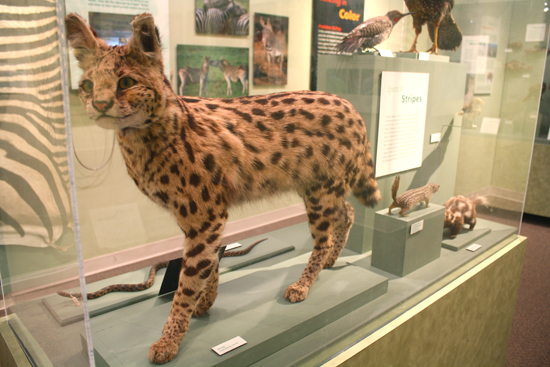Learning the Language of Color
Harvard exhibit explores the role it plays in the animal kingdom

Visit The Language of Color exhibit at the Harvard Museum of Natural History and you’ll find yourself surrounded by all kinds of stripes and spots. Photo by Tom Vellner (COM’13)
While it may take only a flirty text message or a Facebook request for a college student to attract romantic interest, a new show on view at the Harvard Museum of Natural History reminds us that in the animal kingdom, how the game of love is played is often a question of color. Titled The Language of Color, this stunning exhibit explores the various ways that animals display color—to camouflage, intimidate, and yes, sometimes even to attract a mate.
Visitors will learn about many of the fascinating mating rituals involving color that different species engage in. A male lizard uses push-ups or head-bobs that flaunt vibrant head and neck coloration to impress a female, while a courting bird may perform a ceremonial dance that flashes its brilliant feather colors and patterns to do the same. These methods of attraction aren’t likely to be seen on BU’s campus (except, maybe, at a frat party), but they are, as this show demonstrates, essential to animal communication.
One of the highlights of the exhibit is a video presentation that explains the genetics of zebra striping. The elaborate black-and-white designs are not accidental, but take form when a certain gene is triggered during fetal development.
The gallery is filled with striking portraits of iguanas, cases filled with butterflies and beetles, even a nine-foot hide of a mountain zebra. Displays featuring real bird, mammal, reptile, fish, and mollusk specimens are found throughout the exhibit. Peer into a terrarium and try to spot the live dart frogs, which use colors to warn predators that they are a bad choice of food—poisonous, in fact.
The Language of Color is a reminder of the vital role that color and pattern play in the animal world and will leave you with a new appreciation for the intricacy and vibrancy to be found from one species to the next. If nothing else, you might gain a tip from a reptile on how to score a date.
The Language of Color is on view at the Harvard Museum of Natural History, 26 Oxford St., Cambridge, through Monday, September 30. The museum is open daily from 9 a.m. to 5 p.m. Admission is $12 for adults, $10 with student ID, $10 for seniors (65+), $8 for children 3–18, and free for children under 3. Hop on the #66 Bus toward Harvard Square at the intersection of Harvard Ave. and Brighton Ave., hop off at the Johnston Gate stop, and walk for about six minutes to the museum.
Watch a tour of the exhibit here.
Tom Vellner can be reached at tvellner@bu.edu. Follow him on Twitter at @tomgvellner.
Comments & Discussion
Boston University moderates comments to facilitate an informed, substantive, civil conversation. Abusive, profane, self-promotional, misleading, incoherent or off-topic comments will be rejected. Moderators are staffed during regular business hours (EST) and can only accept comments written in English. Statistics or facts must include a citation or a link to the citation.